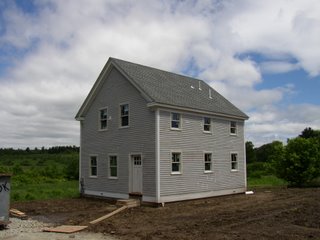I was going to be very systematic about my postings, walking through the different steps of building a home and my comments about each, but I had my blower door test yesterday and it was so neat I had to break with my plans.
A blower door is a powerful fan that mounts into the frame of an exterior door. The fan pulls air out of the house, lowering the air pressure inside. The higher outside air pressure then flows in through all unsealed cracks and openings. This test is required for Energy Star for Homes certification. See www.energystar.gov. Energy Star for Homes certification is a mandatory element in the LEED for Homes certification process. Energy Star certification costs about $465, though if you are a customer of a commercial utility, they may pay for some or all of the cost of the certification. I subscribe to a municipal utility and therefore have to absorb the entire cost myself, but I think it's definitely worth it. LEED certification is more (more on this in the future), but it includes the Energy Star cost.
My understanding is that you would normally do your blower door test when the house is pretty much finished, but my builder, LEED rater and SIPs supplier were so curious to see how the test turned out at the rough phase that they're doing the first test for free. I was lucky to be at the house painting when Ken the LEED rater came to do the test and he invited me in. There were some holes that had to be taped up (a gap over my cellar door and a hole in my doors where the deadbolt hasn't been installed yet as well as the not-yet-completed radon vent). When done, he turned on the big fan and calibrated it to get the controlled reading.
The test results are a little over my head, but the long and short of my understanding is that we had half the allowable miminum air leakage for a house of my type and size. And Ken said that when the wallboard and trim go up, the score will only go up more even if we didn't take steps to identify the leaks.
The leaks were the coolest part of the test. Ken cranked the fan way up and we walked around the inside of the house and held our hands up around the outside of the windows and doors. You could totally feel the air rushing in where there was a gap in the foam sealer. We marked the leaks with blue tape and I'll go around tomorrow to fill them.
Of course, there are downsides to tightness too, namely ensuring the house is properly ventilated. The Energy Star folks said that two bathroom fans would adequately ventilate the house. The SIPs people and plumbing contractors said an HRV (heat recovery ventilator) or ERV (energy recovery ventilator) would be needed ("If you cook bacon, you'll smell it for two weeks!) Ah, just one of many examples of different people telling me different things, and me not having the info to feel comfortable about choosing one over the other. The original price we got on an HRV was $1,500 (vs. probably $300 for the bathroom fans), but the first contractor we talked to quoted us $3,000 for an ERV (better in humid situations). This was to duct on two floors. We found another guy who suggested an HRV system that would just duct the second floor for $2,000. At this point, I don't have the specs on it, but it seems like a good compromise. I guess one of the concerns about HRVs historically is that they use a fair amount of electricity, but this one's pretty small. I'll probably turn it off altogether in months when I have windows open all the time. I'll have to confirm this is the way to go.
Maybe next posting I'll return to my plan to discuss the design process for my house, or maybe I'll find something else more interesting to break in with!


